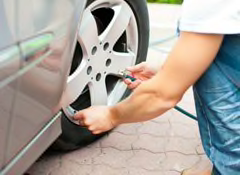All new cars and light duty trucks 10,000 lbs or less have tire pressure monitoring systems required by law. The tire pressure monitoring system can detect when one or more of the vehicle's tires are 25 percent or more below the recommended inflation pressure.
According to NHTSA, under-inflated tires can adversely affect fuel economy, lead to skidding and loss of control and hydroplaning on wet surfaces. It can also increase stopping distance and the likelihood of tire failures.
Tire pressure monitoring systems are not meant to be used as substitute for performing routine maintenance such as checking for tire pressure routinely. Even the most effective tire-pressure monitors can't compensate completely for poor tire maintenance. Here's how to help keep your tires as safe as possible:
Do your own pressure checks. Overinflated tires ride harshly and wear unevenly. Underinflated tires also wear unevenly, handle poorly, and may flex excessively, causing overheating and possible failure. Tires lose roughly 1 pound per square inch of pressure for every 10° F drop in outside temperature. They also lose air over time; pressure loss was as much as 13 pounds per square inch per year in our tests of passenger-car all-season tires. Check pressures at least once a month when a vehicle has sat for at least one hour and tires are cool; pressures should match those on the vehicle placard.
Inspect the sidewalls and tread. Cuts or bulges are signs of impending failure; replace such tires. Check the tread periodically with a tread-depth gauge; uneven wear may mean improper wheel alignment or worn suspension parts. Rotate tires every 6,000 to 8,000 miles or as advised in your owner's manual to help equalize wear between front and rear.
Replace all four tires at once. Many drivers replace only two tires at a time if the other two appear sound. We believe the risks aren't worth the savings. Replacing only the front tires increases the chance of fishtailing at the rear. Replacing the rear tires alone denies you the added resistance to hydroplaning you're likely to get by mounting new tires up front. Still, if you purchase only two tires, be sure to have the new tires placed in the rear for sake of secure handling.
Tire Age. Tires do age and become unusable after time regardless if they were in service or not.
Some auto manufacturers like Audi, BMW, Ford, and Volkswagen recommend replacing tires after six years, and some tire manufacturers agree that any tire ten years or older should be replaced regardless of tread wear.
The bottom line. Buy the newest tires possible, no older than one or two years old. (Read: How to decode tire size and other data.) Replace a tire following the auto manufacturer age recommendation if there is one and do not use any tire that is ten years or older. We believe that most consumers will wear out tires before age becomes an issue. We recommend checking the tires for cracking or damage every time you check air pressure, about once a month.





















